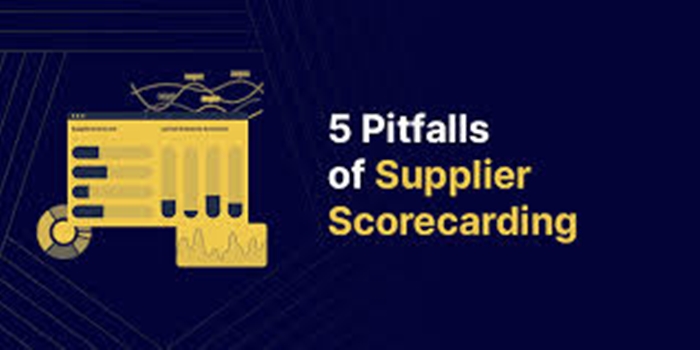In this article, we explained supplier scorecards, the objectives, the components, how to develop a supplier scorecard, the examples, the benefits, and the future.
Definition
Supplier scorecard is a performance management tool that evaluates and tracks a company’s suppliers based on predefined criteria like quality, delivery, cost, and service. It helps businesses make informed decisions, foster stronger vendor relationships, and drive continuous improvement in the supply chain by systematically consolidating and comparing supplier performance.
Objectives of a Supplier Scorecard:
Measure and monitor performance: To systematically evaluate and track how suppliers perform on key metrics like quality, on-time delivery, cost, and service.
Drive continuous improvement: To provide suppliers with clear, data-driven feedback on their strengths and weaknesses, encouraging them to meet and exceed performance standards.
Support informed decision-making: To provide the data needed to make well-informed decisions about which suppliers to partner with, which to develop, and which to switch from.
Standardize and ensure consistency: To use the same metrics and standards for all suppliers, ensuring a fair and consistent comparison across the supply base.
Improve communication: To open up a clear and objective dialogue with suppliers about their performance and your expectations, fostering better relationships.
Manage risk: To identify potential risks in the supply chain early on, such as quality issues or delivery delays, before they become significant problems.
Ensure alignment: To confirm that suppliers are aligned with the overall objectives and requirements of the business.
The Components of Supplier Scorecard:
Quality: Measures adherence to product or service standards, such as defect rates and compliance with specifications.
Delivery: Assesses timeliness and reliability, including on-time delivery rates and order accuracy.
Cost: Evaluates cost-effectiveness, including pricing, cost management practices, and total cost of ownership.
Compliance: Ensures the supplier meets all legal, safety, and contractual obligations.
Responsiveness: Measures how quickly and effectively the supplier addresses inquiries, feedback, and problems.
Innovation: Gauges the supplier’s ability to contribute new ideas, technologies, or process improvements.
Risk Management: Assesses supplier stability, resilience to disruptions, and financial health.
Sustainability and Social Responsibility: Covers a supplier’s performance on environmental practices and ethical standards
How to Develop a Supplier Scorecard
Step 1: Define Objectives
Clarify the purpose of the scorecard — is it for risk management, continuous improvement, performance benchmarking, or strategic sourcing?
Step 2: Identify KPIs
Select key performance indicators relevant to your industry and goals. Involve cross-functional teams (quality, logistics, R&D) in defining the metrics.
Step 3: Assign Weightings
Not all metrics carry the same importance. Assign weights to each category (e.g., 40% quality, 30% delivery, 20% cost, 10% sustainability).
Step 4: Automate Data Collection
Leverage ERP systems, supplier portals, and procurement tools to gather real-time data. Minimize manual input to reduce errors and bias.
Step 5: Review and Calibrate
Regularly review the scorecard’s relevance. Adjust metrics as business priorities or supplier relationships evolve.
The Examples of Supplier Scorecard:
Performance and quality
On-time delivery rates: Measures how consistently a supplier delivers on schedule.
Quality and defect rates: Evaluates the consistency and reliability of products to ensure they meet standards.
Order accuracy: Ensures the correct product and quantity are delivered.
Cost and financial
Cost competitiveness: Assesses how well the supplier manages and controls expenses to maintain competitive pricing.
Cost metrics: Specific financial data points like the impact of a Duty Drawback program can be tracked,
Service and process
Responsiveness to inquiries: Measures how quickly and effectively the supplier responds to questions or issues.
Ease of business processes: Evaluates the efficiency of interactions, such as order placement and communication.
Regulatory compliance: Ensures a supplier meets all relevant legal and industry standards.
Risk and sustainability
Supplier Risk Score: A score derived from risk factors, sometimes ranked using a color-coded system.
Sustainability metrics: Some companies, like Salesforce, track a supplier’s progress toward science-based targets.
Benefits of Supplier Scorecards:
Improved performance: Scorecards provide a clear, data-driven view of supplier performance against predefined metrics, helping to identify issues and drive improvements.
Cost management: They help identify inefficiencies and areas for cost reduction, which can lead to significant savings through better waste reduction and inventory management.
Risk mitigation: By continuously monitoring performance, companies can proactively identify and address potential risks before they impact the supply chain.
Enhanced communication: Scorecards create a transparent and consistent framework for communication between businesses and their suppliers, fostering better relationships and a shared understanding of expectations.
Data-driven decision-making: They replace guesswork with objective, measurable data, allowing for more informed decisions on supplier selection, negotiation, and strategy.
Continuous improvement: The evaluation process encourages suppliers to continuously improve their quality, on-time delivery, and other key performance indicators (KPIs).
Better forecasting: Real-time performance data from scorecards can improve forecasting for inventory requirements and delivery lead times.
The Future of Supplier Scorecards
Predictive Analytics
AI and machine learning can analyse scorecard trends to forecast potential failures or improvement opportunities.
Sustainability and ESG Metrics
Environmental, social, and governance (ESG) KPIs are becoming mandatory in many industries and geographies.
Supplier Portals and Collaboration Tools
Real-time supplier feedback and performance dashboards improve transparency and collaboration.
Integrated Performance Management
Scorecards will evolve into comprehensive supplier performance management platforms integrated with risk and contract management tools.
Conclusion
A well-designed supplier scorecard is a strategic asset that goes beyond tracking performance, enabling procurement teams to improve supplier relationships, reduce risk, and drive value. By providing a data-driven, objective evaluation, it shifts organizations from simply reacting to issues towards proactively developing suppliers and making strategic sourcing decisions.


